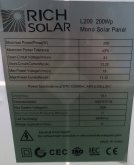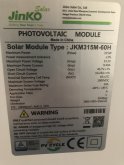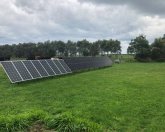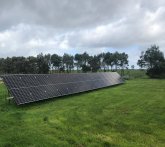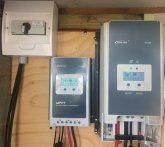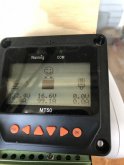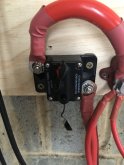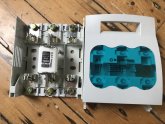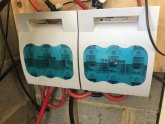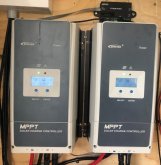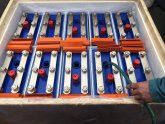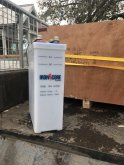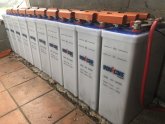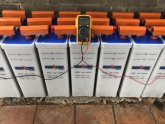jimbo78
New Member
-Nickel-Iron (NI-FE) 1000ah 12V (12kw of usable storage)
-5kw of panels
-4kw Reverse Cycle AC for heating and cooling (~900w electrical power)
Hi everybody,
I have been busy building my solar system which is primarily designed to heat my house in the winter. I initially looked at lithium-based battery tech but decided against it which I will go into in later posts. I’m located on the outskirts of Melbourne Australia, so we have quite a mild climate here compared with many places in the US. The worst month is July with an average temperature of 7-14C (45-57F). Previously I was heating my house with wood and I would consume around $1400 of wood per winter.
This system at this point is experimental as I was not sure what to expect with the Nickel-Iron battery technology, but 5 months in I’m very comfortable with the technology and I thought a bunch of you guys would also be very interested. I will go into specifics of my system, I have collected a lot of data of my system from the very first cycle up until now (see below). I have only needed to light the fire once since switching over for heating mid-August, the system is not large enough to run 100% of the time, but if I only need to burn wood less than 10% of the time in the middle of winter then it’s a win in my book. I also expect to be able to upscale this system for 100% heating in the future, and I will go into how I intend to do that also.
I will also say that there is a lot of negativity and doubt around NI-FE as a useful technology. Sure these batteries may not be as “Turn key” as some others, but I don’t think they are as bad as many try to make them out to be. All batteries require some amount of supervision and maintenance even if its just dusting them off and/or re-buying them once they are spent. I look at my batteries as family heirlooms and I expect them to not only outlive myself but I fully expect to hand them down.
Overview of my systems data so far.
Totals
Source 1317.39kWh, Load 1006.65kWh
Battery Voltage Range
Min 9.99V, Max 16.96V
Battery Cycles
72.95
Return On Investment
$314.15
So, over the coming weeks I will be posting pictures and details of my system so far, why I choose this route, my mistakes so far, and where I intend this system to go into the future. Along the way I’ll be happy to answer any questions you may have so please ask away however I will be posting my main topics first which may cover many of your questions. Once the main posts are covered I’ll then focus on any specific questions that were not covered.
-5kw of panels
-4kw Reverse Cycle AC for heating and cooling (~900w electrical power)
Hi everybody,
I have been busy building my solar system which is primarily designed to heat my house in the winter. I initially looked at lithium-based battery tech but decided against it which I will go into in later posts. I’m located on the outskirts of Melbourne Australia, so we have quite a mild climate here compared with many places in the US. The worst month is July with an average temperature of 7-14C (45-57F). Previously I was heating my house with wood and I would consume around $1400 of wood per winter.
This system at this point is experimental as I was not sure what to expect with the Nickel-Iron battery technology, but 5 months in I’m very comfortable with the technology and I thought a bunch of you guys would also be very interested. I will go into specifics of my system, I have collected a lot of data of my system from the very first cycle up until now (see below). I have only needed to light the fire once since switching over for heating mid-August, the system is not large enough to run 100% of the time, but if I only need to burn wood less than 10% of the time in the middle of winter then it’s a win in my book. I also expect to be able to upscale this system for 100% heating in the future, and I will go into how I intend to do that also.
I will also say that there is a lot of negativity and doubt around NI-FE as a useful technology. Sure these batteries may not be as “Turn key” as some others, but I don’t think they are as bad as many try to make them out to be. All batteries require some amount of supervision and maintenance even if its just dusting them off and/or re-buying them once they are spent. I look at my batteries as family heirlooms and I expect them to not only outlive myself but I fully expect to hand them down.
Overview of my systems data so far.
| Month | Source (kWh) | Load (kWh) | Batt Out (kWh) | Voltage | Cycles | ROI |
| July | 26.02 | 24.99 | 22.11 | 16.07 - 10.24 | 6.15 | $7.40 |
| August | 228.49 | 169.30 | 133.17 | 16.77 - 10.02 | 20.35 | $47.81 |
| September | 288.38 | 224.36 | 140.20 | 16.72 - 9.99 | 15.28 | $68.63 |
| October | 366.55 | 295.02 | 134.91 | 16.75 - 10.63 | 13.10 | $92.90 |
| November | 326.65 | 243.76 | 71.09 | 16.96 - 10.46 | 12.78 | $80.73 |
| December | 81.30 | 49.23 | 22.37 | 16.31 - 12.55 | 5.29 | $16.67 |
Totals
Source 1317.39kWh, Load 1006.65kWh
Battery Voltage Range
Min 9.99V, Max 16.96V
Battery Cycles
72.95
Return On Investment
$314.15
So, over the coming weeks I will be posting pictures and details of my system so far, why I choose this route, my mistakes so far, and where I intend this system to go into the future. Along the way I’ll be happy to answer any questions you may have so please ask away however I will be posting my main topics first which may cover many of your questions. Once the main posts are covered I’ll then focus on any specific questions that were not covered.





